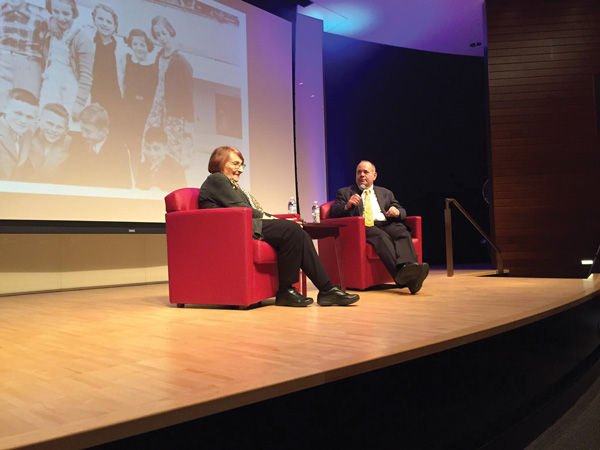Parallels drawn between WWII Jewish, today’s Syrian refugees
Published November 4, 2015
Leah Kadden and other German Jews aboard the SS St. Louis in 1939 were provided with a separate room for Shabbat services and “allowed to turn a Hitler picture into the wall,” she said. But many of the passengers would again face the Nazis because the Cuban and American governments in turn denied them entry.
After they landed in Belgium, Kadden said, her mother “just broke down and cried.” Her father had been sent to the Sachsenhausen concentration camp before the St. Louis left Germany.
Kadden, who was then 9 years old, recalled her experience Oct. 28 at the St. Louis Public Library as part of a U.S. Holocaust Memorial Museum program.
She and other speakers likened the story of the refugees aboard the St. Louis to the stories of Syrian refugees trying to enter Europe and the United States today. And that, of course, raised questions about whether the Western world is living up to the promise of “never again.”
From Brussels, Kadden, her mother and her older brother tried to enter France. They were walking among a group of people at the border when a bicyclist passed them and a piece of fox fur that her mother was wearing got caught in the wheel, Kadden recalled. Her mother ran after him, yelling “My fox! My fox!” The children followed suit and in doing so, they inadvertently avoided having to show their papers and made it into France.
The family eventually traveled to Switzerland and then the United States. Kadden now lives in Chicago.
Of the 937 passengers on the St. Louis, 288 were admitted by Great Britain, while the rest, at least initially, were stuck in Western Europe. Some managed to emigrate before the Nazis invaded. Others survived in Europe, and 254 were killed in concentration camps or died elsewhere during the war.
Scott Miller is the Holocaust museum’s director of curatorial affairs and the author of “Refuge Denied,” a book about the St. Louis. He recalled his detective work trying to locate passengers who had survived the war, some of whom had changed their names.
Miller went on National Public Radio and told the story of Rudi Dingfelder, who was 16 years old when he boarded the ship. He and his family were later deported to the Auschwitz concentration camp, where his parents were sent to the gas chambers and he was sent into a line for forced labor.
After the interview, Miller received a call from a man in El Paso, Texas, who relayed that he had once heard a story about a relative, Robert Felder, who worked as a toolmaker at Auschwitz and survived but had since died.
The historian eventually connected the dots to Dingfelder’s widow, Gerry, who told Miller that her husband had been wearing glasses when he reached Auschwitz. When he was yanked off the train, his glasses flew off his face, which he thought would make him look weak and that he would be sent to the gas chamber. Instead, it saved him because the guards thought he had normal eyesight and directed him to work.
But he and his parents all could have survived had they been allowed to land in Cuba or the United States.
“With a little less anti-Semitism, a little less xenophobia, a little less anti-refugee sentiment – which is something that should resonate with everyone who is alive today – this could have been a great rescue story,” Miller said. “America could have let these people in.
“Instead it was a really senseless and tragic story that did not have to happen.”
These days, when Kadden watches television and sees the “refugees who are waiting in crowds to get into a country,” she is reminded of her family “who were among a bunch of people who were trying to get into France.”
Kadden shook her head when asked before the talk whether we have advanced to the point where crimes on the scale of the Holocaust could not happen again.
She then said, “You have proof.”














